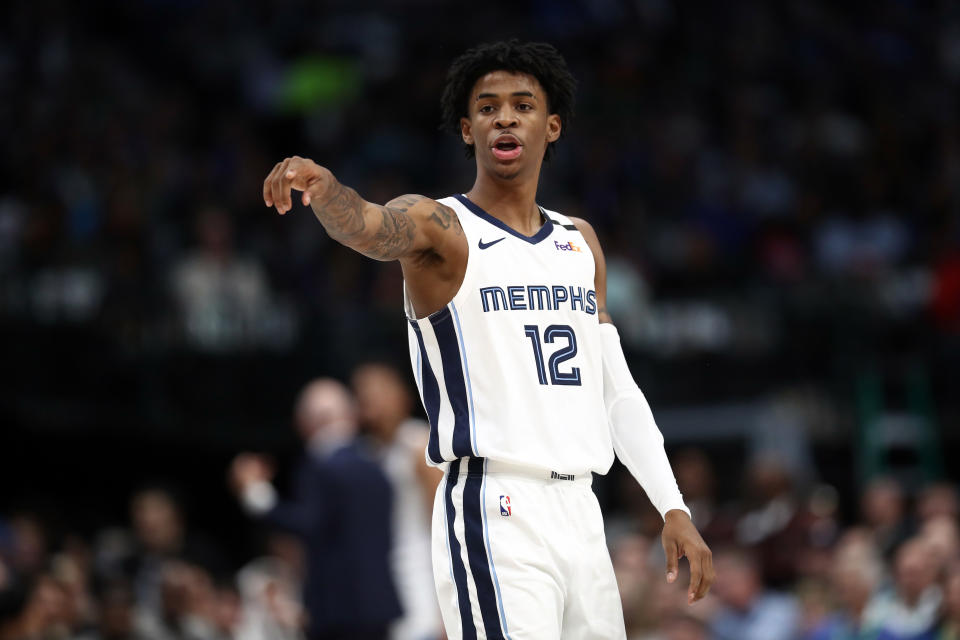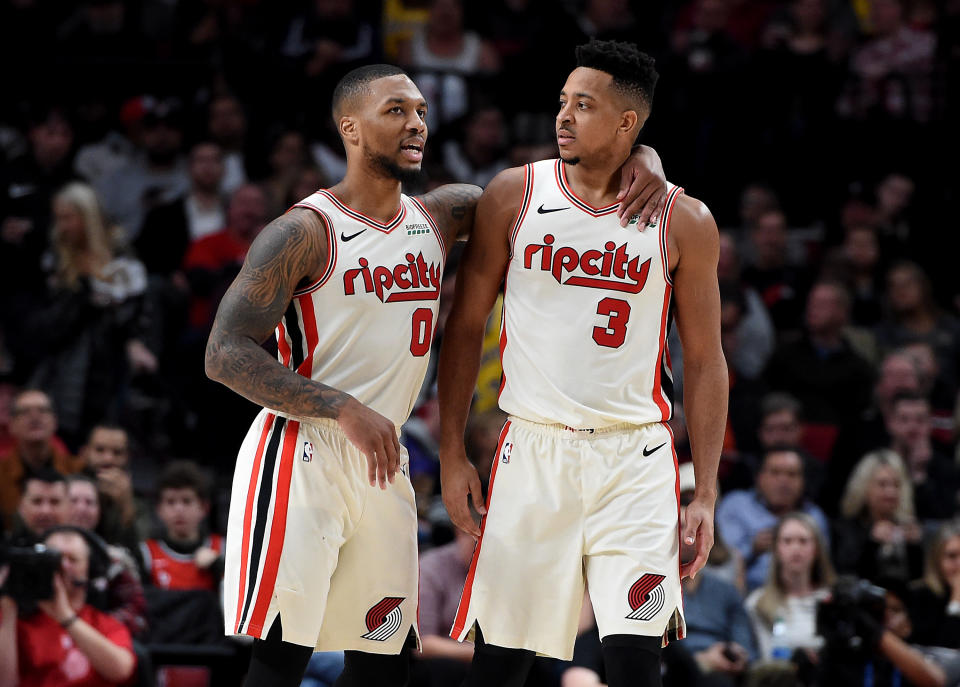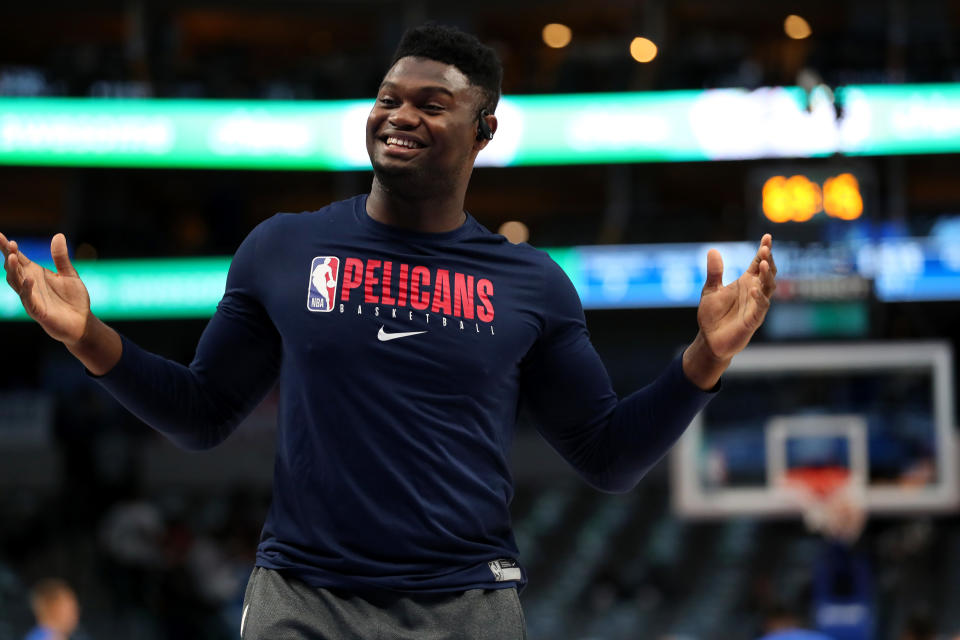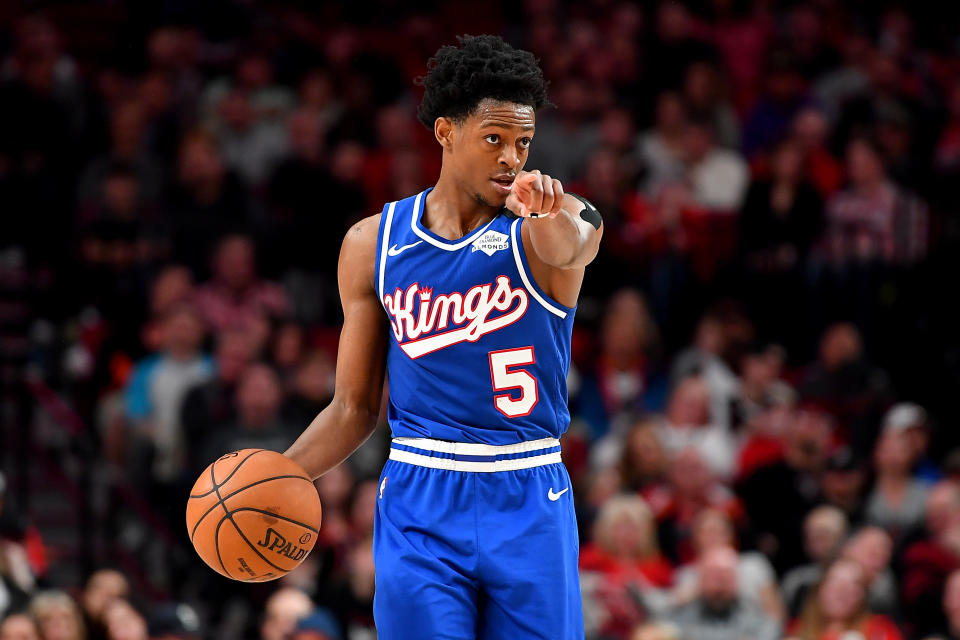Which West team would be the biggest threat to the Lakers as an 8th seed?
For better or worse, the NBA is forging ahead with its plan to restart the 2019-20 season at the end of the month in Orlando, Florida. As teams report to Walt Disney World for training camp, we will dive deep into the big-picture basketball questions left to be answered between now and October.
[A brief history of where the NBA left off and what it means for an impending return]
The race for the eighth seed in the Western Conference is really the only playoff spot left to settle, or at least the only one worth caring about, since whichever depleted team lands the East’s final slot is bound to be pummeled by the Milwaukee Bucks. That is not necessarily the case with the top-seeded Los Angeles Lakers out West, if only because they have already lost a pair of their top-eight rotation players.
The Lakers still boast LeBron James and Anthony Davis, and for that they will be heavily favored against any of six potential first-round opponents, but the question of which team can best capitalize on L.A.’s increased vulnerability — and the likelihood of a meeting — has gotten more interesting in recent weeks.
The Lakers are massive up front with James, Davis and some combination of JaVale McGee or Dwight Howard most often comprising their frontcourt defense. That generates obvious advantages at the rim, both offensively and defensively, but it also leaves them susceptible in areas that are exacerbated by the losses of Avery Bradley (opted out of the restart) and Rajon Rondo (out 6-to-8 weeks with a thumb injury).
Opponents can put pressure in transition on the turnover-heavy Lakers, who allow more fast-break points than any other team, even as they feature James and Danny Green, two of the best chase-down defenders in the game. Prolific shot-creating guards can also wreak havoc on the Lakers, both with perimeter shooting and by drawing contact in the paint. (McGee and Howard are especially foul prone, committing 11.1 combined personal fouls per 36 minutes.) Russell Westbrook and Damian Lillard were the two most glaring examples, both scoring 40-plus in two of the Lakers’ four most recent losses.
Conversely, the Lakers’ offense has been average in the halfcourt, especially if you can prevent their massive frontline from beating you on the offensive glass. They pound the rim and find corner shooters when the defense collapses as a result. Taking away both is practically impossible against a team that orchestrates its offense through James, but the more shots you can force from anywhere but those two high-percentage locations puts the onus on a Lakers roster that is void of fear-inducing jump shooters.
With all that said, let us examine how the Memphis Grizzlies, Portland Trail Blazers, New Orleans Pelicans, Sacramento Kings and San Antonio Spurs stack up against the Lakers, and how likely each is to secure the eighth seed. (Apologies to the Phoenix Suns, who trail the 12th-place Spurs by two games and have next to no chance of leapfrogging four teams just to force a play-in series for a playoff spot.)
(Statistics via Cleaning the Glass and Second Spectrum.)

Memphis Grizzlies (32-33)
Vs. the Lakers: 1-3
James and Davis traded off bludgeoning the Grizzlies in their first two meetings, and both dominated in the Lakers’ third straight victory over Memphis to start the season. But the season series is a lot closer than the record indicates. The Grizzlies were a bucket away from a season split, and Ja Morant was the measuring stick. When he played well, Memphis hung tight. It is tough to tell how well this translates to the playoffs, where the discrepancy between the young Grizzlies and veteran Lakers will be immense.
Remaining schedule: POR, SAS, NOP, UTA, OKC, TOR, BOS, MIL
The Grizzlies had one of the toughest remaining schedules when the season was suspended, and that is no different now. The front-end of the slate is lighter, and so long as they can navigate the three games against their challengers, they should be in solid position to remain in eighth place, especially if tougher teams at the back-end of their schedule settle their seeding early and start to take their foot off the gas.
Half-court offense: 22nd (93.2 points per play)
Transition offense: 11th off live rebounds (1.3 PPP added); 9th off steals (1.7 PPP added)
3-point offense: 22nd in accuracy (35.6%); 26th in frequency (31.6%)
Offensive rebound rate: 13th (26.0%)
Free-throw rate: 26th (17.7%)
The Grizzlies rely on their youth and athleticism to attack opponents in the open court, but with youth comes the inexperience that generally leads to inefficiency in the halfcourt. If creators Morant and Dillon Brooks can leverage Bradley’s absence, win the turnover battle, convert their pull-up 3-point shooting opportunities and get to the free-throw line more often, Memphis can close the gap offensively.
The ability of big men Jonas Valanciunas, Jaren Jackson Jr., Brandon Clarke and Anthony Tolliver to score inside and out could also bend the McGee or Howard lineups to their advantage. While that could unlock the Lakers with Davis at center, the Lakers are shallow on the wing. Then, it becomes a matter of whether Kyle Anderson, Justise Winslow and Josh Jackson can finish more buckets than Kyle Kuzma and a collection of veteran middlemen, including Green, Kentavious Caldwell-Pope and J.R. Smith.
Half-court defense: 10th (93.8 points per play allowed)
Transition defense: 10th off live rebounds (0.8 PPP added); 24th off steals (1.8 PPP added)
3-point defense: 18th in accuracy (36.3 3P%); 18th in frequency (35.5%)
Rim protection: 7th in accuracy (61.4%); 14th in frequency (35.0%)
Defensive rebound rate: 16th (74.4%)
On paper, the Grizzlies’ defensive strengths match up well with the Lakers’ offensive strengths. They have a handful of big bodies who can counter L.A.’s bully-ball tactics in the paint, but the question that has plagued the league for 15 years remains: Who guards LeBron? Jae Crowder drew that responsibility most often for Memphis, but he was traded at the deadline, and his replacement, Winslow, has been sidelined for much of the season with a back injury. Anderson and Brooks have both taken cracks at James, but the Lakers will be plenty happy knowing LeBron owns the biggest mismatch on the court.

Portland Trail Blazers (29-37)
Vs. the Lakers: 1-2
It is difficult to draw too many conclusions from Portland’s matchups with anyone during the regular season, since the additions of Jusuf Nurkic and Zach Collins will drastically change how the Blazers look on both ends of the floor. But Lillard’s 48-point performance in an early February victory against L.A. is an encouraging sign that the Blazers backcourt is a matchup nightmare for the undermanned Lakers.
Remaining schedule: MEM, BOS, HOU, DEN, LAC, PHI, DAL, BKN
They have an awfully difficult schedule themselves, which makes that season-reopening game against the Grizzlies all the more important. Talent-wise, the defending Western Conference finalists should be confident they can stay within the four-game range necessary to force a play-in series with Memphis. The worry is that one of the three teams within a half-game of them will jump them in the standings.
Half-court offense: 9th (97.3 points per play)
Transition offense: 7th off live rebounds (1.5 PPP added); 30th off steals (0.9 PPP added)
3-point offense: 4th in accuracy (37.8%); 16th in frequency (34.9%)
Offensive rebound rate: 19th (25.0%)
Free-throw rate: 21st (18.9%)
With Lillard and C.J. McCollum, the Blazers can create as well as almost any backcourt in the league. Caldwell-Pope and Alex Caruso could get owned in this matchup, which might force Lakers coach Frank Vogel to call on James and Green to expend some of their energy against quicker guards defensively.
The health of Nurkic and Collins will go a long in determining how potent Portland’s offense could be. If they can be the inside-out partnership we imagined at season’s start, coach Terry Stotts will have plenty of looks to show. Then, there is Carmelo Anthony, the ultimate X-factor. The more efficiently he scores, the more attention he will draw from the Lakers’ top-end defenders, further unlocking the backcourt.
Half-court defense: 18th (95.3 points per play allowed)
Transition defense: 30th off live rebounds (1.9 PPP added); 22nd off steals (1.7 PPP added)
3-point defense: 27th in accuracy (38.2 3P%); 16th in frequency (35.2%)
Rim protection: 2nd in accuracy (59.1%); 23rd in frequency (37.1%)
Defensive rebound rate: 28th (72.1%)
This is trouble for the Blazers. Their defense has holes both in transition and in the halfcourt, especially in the corners, where Green, Caldwell-Pope and Kuzma all excel. The hope is that the return of Nurkic and Collins to a big-man rotation that also includes Hassan Whiteside further bolsters an already stout paint presence and diminish the number of second-chance opportunities the Lakers are so good at securing.
But again: Who defends LeBron? The absence of Trevor Ariza, who opted out of the restart, is a killer, as was the season-ending Achilles injury to Rodney Hood. Anthony has no shot at keeping up with James, and that is a tall order to put on second-year wing Gary Trent Jr. and rookie Nassir Little. The same goes for Davis, whose versatility will force Portland’s rehabbed bigs to work tirelessly on the defensive end.

New Orleans Pelicans (28-36)
Vs. the Lakers: 0-4
The Lakers spanked the Pelicans this season. There is no other way to say it. As exciting as new-look New Orleans has been at times, Davis gave them every reason to rue his departure, averaging 36 points and 12 rebounds in three games against his former team. The Lakers even won their final meeting without Davis for good measure, as James posted a 34-12-13 triple-double opposite Zion Williamson.
Remaining schedule: UTA, LAC, MEM, SAC, WAS, SAS, SAC, ORL
The Pelicans’ schedule is the inverse of the Grizzlies’, as their eight-game slate mirrors what was going to be an easy stretch run before the hiatus. Williamson’s first opportunity to prove himself in a playoff push is upon us, and the world will be watching when they reopen the NBA’s schedule against Utah.
Half-court offense: 17th (94.9 points per play)
Transition offense: 4th off live rebounds (1.8 PPP added); 17th off steals (1.4 PPP added)
3-point offense: 3rd in accuracy (37.9%); 7th in frequency (38.2%)
Offensive rebound rate: 4th (27.4%)
Free-throw rate: 23rd (18.5%)
Since Williamson debuted on Jan. 22, the Pelicans have scored 114.3 points per 100 possessions, a top-10 offense in the league. Playing at the NBA’s second-fastest pace, they have the horses to run the Lakers ragged, with Lonzo Ball, Jrue Holiday and Brandon Ingram also capable of creating in transition.
Ball’s improved 3-point shooting (38.3 percent on 6.5 attempts per game) is an added weapon in the backcourt, where J.J. Redick is elite and Holiday is a threat. Chasing all three in motion is exhausting.
The Pelicans, whose work on the offensive glass generates a ton of second chances, would also love to see Williamson and Ingram get to the line as often as Davis and James, but youth must be served. At the very least, the young Pelicans will make the Lakers work to maintain their offensive advantage.
Half-court defense: 19th (95.6 points per play allowed)
Transition defense: 21st off live rebounds (1.2 PPP added); 17th off steals (1.6 PPP added)
3-point defense: 13th in accuracy (35.8 3P%); 7th in frequency (34.0%)
Rim protection: 10th in accuracy (62.4%); 29th in frequency (39.5%)
Defensive rebound rate: 19th (74.3%)
Likewise, New Orleans’ defensive rating is seventh since Williamson made his debut. He has the size and explosion to defend anyone of significance on the Lakers, and the Pelicans will hope James’ early success against him was a learning experience. Ingram and Derrick Favors also have the length and IQ to make life more difficult for James and Davis. Holiday and Ball have the ability to strangle opposing backcourts, and the Lakers’ lack of wing depth could even help New Orleans hide Redick on defense.
This is of course the most fun possible matchup for the Lakers, and it might also be their most difficult, if only because it will come down to whether Zion can counterpunch LeBron in a heavyweight playoff bout.

Sacramento Kings (28-36)
Vs. the Lakers: 0-2
Sacramento stuck with L.A. defensively in their first meeting, as Harrison Barnes, Richaun Holmes and the since-departed Dewayne Dedmon put in enough work against Davis to keep it a one-possession game. The Kings did not fare so well in their second meeting, when the Lakers barely lifted a finger to score 129 points in a blowout victory. That Bradley, Rondo, Caldwell-Pope and Caruso accounted for 50 of those points can be taken for a fluke or as a sign that Sacramento’s defensive issues run too deep.
Remaining schedule: SAS, ORL, DAL, NOP, BKN, HOU, NOP, LAL
The Kings benefit from a light schedule, especially if the Lakers do them a favor and lay down in the regular-season finale. The two head-to-head games against the Pelicans loom large in this playoff race.
Half-court offense: 19th (94.0 points per play)
Transition offense: 14th off live rebounds (1.2 PPP added); 15th off steals (1.5 PPP added)
3-point offense: 11th in accuracy (36.9%); 11th in frequency (36.7%)
Offensive rebound rate: 22nd (22.4%)
Free-throw rate: 28th (17.5%)
The Kings were left for dead in January, when they had just 15 wins in their first 44 games and began exorcizing unhappy veterans Ariza and Dedmon. They replaced them with Kent Bazemore, Jabari Parker and Alex Len — respectively a beloved teammate and two still-young and once-heralded prospects who better fit an overlooked roster. They proceeded to win 13 of their final 20 games entering the break, essentially drawing even with the Blazers and Pelicans in position to force a play-in series (save for the scheduling quirk that gives Portland a .001 win percentage tiebreaker by way of two additional games).
De’Aaron Fox’s lightning-quick speed and Buddy Hield’s shooting are matchup problems for the Lakers, and the Kings feature a handful of other shooters who could catch fire in a playoff series, namely Bogdan Bogdanovic, Nemanja Bjelica and Barnes. Under the spotlight of the playoffs, though, Sacramento’s struggles in the halfcourt, especially at the rim, could become more glaring. That responsibility may fall on the shoulders of Marvin Bagley, the oft-injured but uber-talented No. 2 overall pick in the 2018 draft.
Half-court defense: 21st (96.9 points per play allowed)
Transition defense: 19th off live rebounds (1.2 PPP added); 16th off steals (1.5 PPP added)
3-point defense: 17th in accuracy (36.0 3P%); 27th in frequency (37.5%)
Rim protection: 30th in accuracy (66.8%); 12th in frequency (34.8%)
Defensive rebound rate: 10th (74.8%)
Sacramento’s greatest defensive weaknesses are L.A.’s greatest strengths, which does not bode well for this matchup. The Kings do not protect the paint or corner threes, and the Lakers will destroy them in both areas unless a number of Sacramento’s wings improved by leaps and bounds over the break.
As much pressure as Fox and Hield could put on the Lakers, the Kings’ frontcourt will have more work to contend with James, Davis and Howard, who could see big minutes against Sacramento’s non-shooting bigs. Barnes is capable on that end, and Holmes is a worker, but if those are the Kings’ best hopes against handling a pair of the league’s five best players for 40-plus minutes a night, prayers are in order.

San Antonio Spurs (27-36)
Vs. the Lakers: 0-3
James and Davis handled the Spurs with relative ease in all three of their meetings, outshining DeMar DeRozan and LaMarcus Aldridge at every turn, as you would expect, given the discrepancy in star power.
Remaining schedule: SAC, MEM, PHI, DEN, UTA, NOP, HOU, UTA
The Spurs quietly have a manageable schedule, especially if Bojan Bogdanovic’s injury proves as big a hit to the Jazz as expected. The Sixers, Nuggets and Rockets are San Antonio’s three most difficult games, and all three are flawed. Of course, we must acknowledge that Aldridge’s season-ending surgery makes the Spurs just as vulnerable, if not more, as he has carried a heavy burden in past playoff pushes.
Half-court offense: 7th (97.9 points per play)
Transition offense: 5th off live rebounds (1.6 PPP added); 5th off steals (1.9 PPP added)
3-point offense: 5th in accuracy (37.5%); 28th in frequency (30.2%)
Offensive rebound rate: 30th (21.3%)
Free-throw rate: 10th (20.6%)
The Spurs have enjoyed surprising success in their three lineups most often used without Aldridge, all of which feature Jakob Poeltl at center and Rudy Gay in a stretch four position. They may lack top-end talent, but they do everything you would expect from a well-coached team, executing efficiently in the halfcourt, keeping turnovers down, shooting better than average and getting to the free-throw line.
DeRozan is especially adept at getting to the line, but his playoff hopes have been spoiled by many a LeBron-led team. Beyond the four-time All-Star and Patty Mills, the Spurs lack playoff-tested weapons, far from what we have been accustomed to seeing from San Antonio in recent decades. But these are not your father’s Spurs, and much will be needed from the promising young guard group of Dejounte Murray, Derrick White, Bryn Forbes and Lonnie Walker if they hope to pose any kind of offensive threat.
Half-court defense: 25th (97.6 points per play allowed)
Transition defense: 25th off live rebounds (1.5 PPP added); 11th off steals (1.4 PPP added)
3-point defense: 26th in accuracy (38.2 3P%); 19th in frequency (35.7%)
Rim protection: 17th in accuracy (64.1%); 11th in frequency (34.1%)
Defensive rebound rate: 4th (76.3%)
Those same Poeltl-anchored lineups have been subpar defensively. The strength of San Antonio’s defense is in its backcourt, where the long arms of Murray and White can be disruptive, but neither has the strength to cover James with any degree of consistent success. Much would be asked of Gay and Trey Lyles opposite James and Davis, and not even Gregg Popovich can make that recipe palatable.
More from our NBA restart series:
Can the Rockets catch lightning in the bubble and win an NBA title?
Can the 76ers finally figure out their chemistry issues with a restart?
– – – – – – –
Ben Rohrbach is a staff writer for Yahoo Sports. Have a tip? Email him at rohrbach_ben@yahoo.com or follow him on Twitter! Follow @brohrbach.
More from Yahoo Sports:

 Yahoo Sports
Yahoo Sports 
